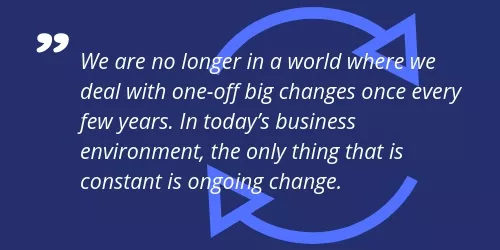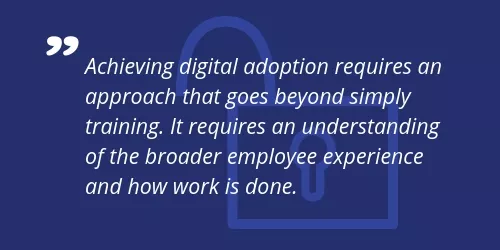If you want your digital transformation to succeed, you can’t be laser-focused on technology.
It may be counterintuitive. But most of the time, the designers of digital transformation aim all of their attention and resources on the tech aspect and make the colossal error of ignoring the human factor. Choosing the right technology is only the first step to driving successful digital change. Actually, it’s step 0.
Everything that follows is about people, according to Andrea Schnepf, Managing Consultant at nepf LLC. If you want your change effort to succeed, you need the change management infrastructure in place to support the cultural, management, and training needs of your workforce.
Schnepf, who works with transformation leaders to drive enterprise change, talked to us about the importance of the human factor to thriving in a rapidly changing digital business landscape.
Note: This interview has been lightly edited for clarity and brevity.
Question: Which factors most commonly slow down digital transformation?
Answer: What we have found across many case studies and engagements is that the key factors that slow down digital transformation all relate to people and organizational factors.
These include leadership, mindset, and behaviors across the entire workforce, capabilities and skills available, the right employee experience, governance, and how the company is organized to enable innovation.
We assess those key factors first so that we can quickly address the key barriers that are slowing down progress.
Q: What must leaders do to ensure change goes smoothly in an organization?
A: We are no longer in a world where we deal with one-off big changes once every few years. And we no longer have the one big go-live that we  train for and get ready for, and then go back to normal. In today’s business environment, the only thing that is constant is ongoing change.
train for and get ready for, and then go back to normal. In today’s business environment, the only thing that is constant is ongoing change.
As a result, leaders need to focus on the overall change-readiness of the organization.
This requires entirely new approaches to change management, and leaders need to invest in the overall change readiness of their people and organization to be successful. That means throwing out many of the old approaches and looking at the ongoing change experience. We call this Change X.
The important thing to understand is that digital transformation and what it stands for doesn’t really have an ending point. We see that some of the most innovative companies in the world — Google, Amazon, Apple — constantly innovate and re-invent new products, services and entirely new business models. It can’t be different for other companies either — the business environment is only going to change faster.
Q: You speak a lot about the human side of change management. What are the most common pitfalls leaders make in this regard when launching a digital transformation?
A: The two key challenges that we see frequently are not designing a compelling experience and not focusing on changing behavior.
We know from recent studies that consumers today will in many cases favor convenience over price when making personal purchasing decisions.
Of course, this translates to how people are at work. If you can design an experience for your people that they see as supporting them in achieving their work objectives, they will be on board and will adopt the new tools and processes you are implementing with minimal convincing.
Next on your reading list: How to Decode Digital Transformation in an Era of Constant Change
Another challenge is failing to understand people’s motivation and gaining their support
In our increasingly digital and connected world, training “How-Tos” are outdated, and the days of multi-day training programs to prepare for an implementation are a thing of the past. Instead, they are now easily supplemented and replaced with more convenient and more effective “on demand” prompts and “Point-Of-Need” support that is intuitive.
More important as a means to achieve real business results is to drive effective behavior change. For example, let’s say the business goal is for front-line staff to become more customer-centric. Yes, of course, there is an element of teaching your people about who the customer is and what good experiences look like and the steps to follow, but a bigger element is creating the motivation for your staff to apply this in their day-to-day work and making it a habit.
Q: Why are so many companies struggling to see a positive return on their software investments?
A: This builds heavily on my previous point regarding designing a compelling user experience without focusing on behavior change. 
Achieving digital adoption requires an approach that goes beyond simply training. It requires an understanding of the broader employee experience and how work is done.
For example, a new dashboard that provides insights from cross-functional data and analytics on that data will not result in business value if it isn’t made an integral part of meetings where decisions are made.
How do companies squeeze the lemon in terms of ensuring they get the most ROI out of their software? How do they make sure their employees are just plain productive on these new tools?
Maximize your software ROI with a Digital Adoption Platform (DAP). Request a demo today.
Q: What can companies do to safeguard their software investments and achieve the return they’re looking for?
A: Each situation is different, but in general, it comes down to the following three areas:
The first is not making the right investments to start with. The tool or software may have a great impact elsewhere, but if it doesn’t solve the right business problem for your organization, you will not get ROI. Companies need to make sure they focus on the right business issues, instead of buying technologies for the sake of having them.
Dive deeper: Why foregoing software “insurance” could be your costliest mistake
The second is getting the user experience right. You could have all the latest and greatest software, but if your end users do not intuitively know where to find what they need for their immediate request or task, then in most cases your productivity, and as a result, your ROI will suffer. We work with companies to help them understand the overall user experience of their people and streamline it in a way that makes it intuitive for the employees to do their work.
Third is to have the right change experience — Change X. Employees need to be enabled effectively to work with these tools and be supported in integrating it into their work. For example, with most online software today — be it Salesforce, ServiceNow or similar — we can expect regular updates and new releases. So, we need to prepare for this and have the ways of working in place that can quickly adopt and aren’t disrupted by these inevitable ongoing changes.
Q: What’s the one big “takeaway” you want readers to know about achieving a strong ROI on software investments?
A: In the end, it comes down to leadership, people and organization. We have worked with companies who had all the latest tools and technology and expected a return. But the ROI wasn’t there. A subsequent relatively much smaller targeted investment, in people and organization, transformed this and provided immense returns.

